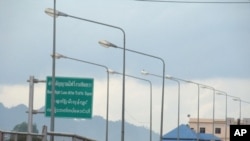Thousands of people every year flee Burma for neighboring Thailand. They are escaping conflict and persecution and are looking for work. Most end up doing casual labor in farms and factories while others become refugees, living in one of several crowded camps along the border.
Hundreds of people a day cross the porous border from Burma into Thailand, fleeing abuse and seeking economic opportunity.
At a small clothing factory in the Thai border town of Mae Sot, a long table of Burmese workers are using steam irons on nautical-themed shirts. Thailand's factories often pay migrants below minimum wage. But for people from Burma it is still better than back home.
In an open air workshop, at the Mae Tao clinic in Mae Sot, a man holds a prosthetic leg up to a grinding stone, smoothing away the edge.
The plastic leg belongs to Saw Thu Ra, who lost his real leg when he was shot by soldiers in Burma 20 years ago.
The two men working in the shop are also missing legs. Saw says many civilians in Burma lose their legs, especially from stepping on land mines or being shot by the Burmese military.
Saw lives now in a refugee camp in Mae Sot, Thailand, along the border with Burma but comes to the clinic when his prosthetic needs touching up.
Dr. Cynthia Maung is the clinic's director. She says they see about 150,000 patients every year. Half have crossed over from Burma. She says those numbers are growing by 15 percent a year. "Not only the number increase. More severe illness or more people come far away inside Burma," she said.
She says the health care situation in eastern Burma is getting worse and clashes between the military and ethnic-based militias are not helping.
More than 150,000 people from Burma live in Thailand in camps like Mae La.
The sprawling complex of thatched and wooden huts surrounds the base of a small mountain and is fenced-in by a busy road.
Standing outside of Mae La camp, Kitty McKinsey, a spokeswoman for the United Nation's refugee agency, says refugees tell horror stories about their lives in Burma. "Young men don't sleep in their own homes because they're afraid of being conscripted by the army, being used for forced labor, unpaid labor, and people are even being used as human landmine detectors, being forced to walk in front of soldiers across landmines," she said.
She says refugees in Thailand are not allowed to legally work outside the camps, so making a living can be difficult. But their biggest challenge is getting recognition as refugees.
There are 90,000 U.N. recognized refugees from Burma living in Thailand and 56,000 more waiting for refugee status.
Thailand tolerates them but considers them displaced persons who must eventually return to Burma or go elsewhere.
Naw Eh Wah and her family fled Burma seven years ago after Burma's military attacked their village. Since then, she's been living in Mae La camp. But now, she's boarding a bus, alone, for a trip to the airport and what she hopes will be a better life in the United States. "So, even I stay in Thailand just will be like that, nothing improve for me. That's why I'm decided to go to USA. And, if I have a chance to go and work hard, one day I will come back to my family," she said.
The International Organization for Migration has resettled about 66,000 refugees from Burma in the last five years, most in the United States.
The IOM says until conditions improve in Burma, people will continue to move across the border in search of something better.












